Skjærtorsdagsmessen i Laterankirken
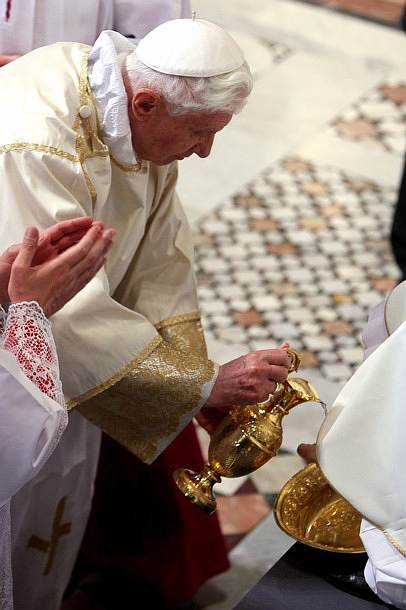
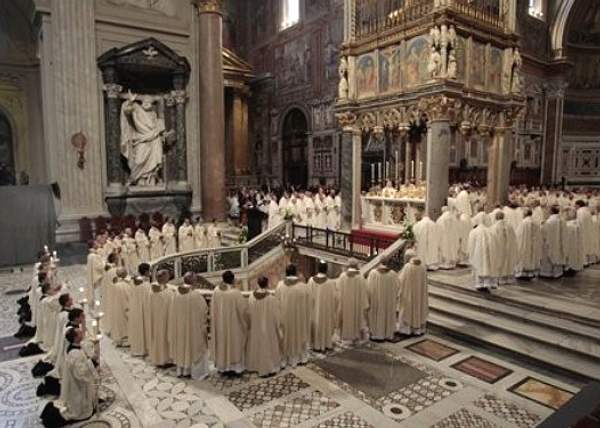
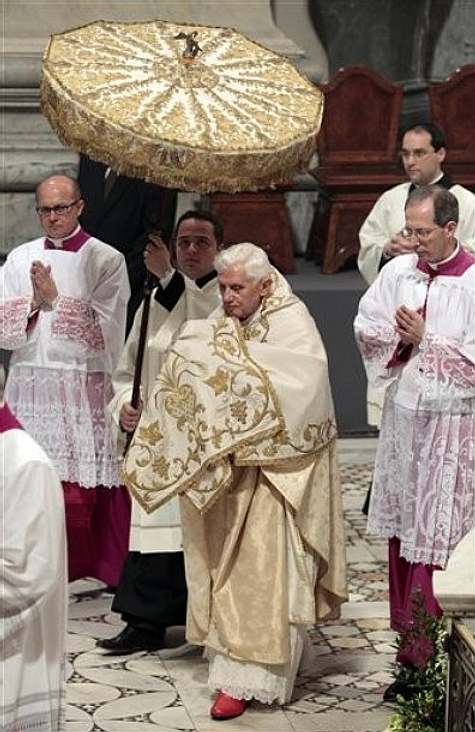
John Allen har som vanlig en god og presis analyse av stridsspørsmål innen Kiriken; i debatten om det var dokumentene Vatikankonsilet produserte eller bare den senere fortolkningen av dem som er problemet, plasserer han pave Benedikt midt i sentrum av debatten – med en balansert forståelse:
…. When it comes to interpretations of the Second Vatican Council (1962-65), some progressive Catholics are tempted to see Pope Benedict XVI’s “hermeneutic of reform,” which stresses continuity with the pre-Vatican II church, as the opposite end of the spectrum from more liberal views. That’s not, however, how most people in the Vatican size things up, where the “hermeneutic of reform” is instead understood as a balanced position between thinking that church history began with Vatican II, and thinking that the council was just plain wrong.
For that taxonomy to work, there have to be credible exponents of the “just plain wrong” position. That’s where Italian historian Roberto de Mattei and Monsignor Brunero Gherardini, a canon of St. Peter’s Basilica, enter the picture.
Both have published provocative books about Vatican II. Last year, de Mattei offered Il Concilio Vaticano II: Una storia mai scritta (“The Second Vatican Council: A Story Never Told”), styling Vatican II as a rupture with tradition comparable to the French Revolution, and faulting every pope since Pius X for allowing it to happen. Gherardini produced Concilio Vaticano II: Il discorso mancato (“The Second Vatican Council: The Missing Discussion”), in which he said some council fathers believed “the church was to be a kind of research laboratory rather than a dispenser of truths from on high.”
Both books were recently reviewed in L’Osservatore Romano, the official Vatican newspaper, and in both cases the verdict was fairly negative. The commentary on de Mattei came from Italian Archbishop Agostino Marchetto, author of a study of the council openly critical of the more liberal “Bologna school” associated with Italian scholars Giuseppe Alberigo and Alberto Melloni. Marchetto wrote that de Mattei’s work is “ideological” and suffers from “extremist tendencies.” Likewise, Inos Biffi, a medieval expert and a frequent writer for L’Osservatore, charged that Gherardini doesn’t so much “discuss” Vatican II as “denigrate” it.
The dividing line is this: If the post-Vatican II period brought some confusion and excess, is that the fault of the council itself? Benedict XVI, and figures in sync with his views such as Marchetto and Biffi, say no; traditionalist critics such as de Mattei and Gherardini say yes.
All this illustrates a core insight about the Catholic Church: Deciding who the moderates are depends on the range of views one takes into consideration. When you see the whole picture, it’s often tougher to conclude that the Vatican, or the pope, represents an extreme.
Les hele John Allens innlegg her – helt på slutten av artikkelen.
Vårt Land tar i dag med følgende NTB-melding om palmesøndag på Petersplassen – men har ikke med de fine bildene under:
Paven, som fylte 84 år lørdag, ledet en fargerik markering i strålende solskinn på Petersplassen. Både kardinaler, biskoper, prester og tusenvis av vanlig troende hadde med seg palmeblader for å feire palmesøndag.
Paven la stor vekt på menneskets forhold til Gud i sin tale og ba om at «vi må være en del av generasjonen som søker Gud».
Palmesøndag innleder påskehøytiden og markerer Jesu inntog i Jerusalem søndagen før korsfestelsen. Paven har en hektisk uke foran seg som avsluttes første påskedag, når han skal gi sin tradisjonelle Urbi et Orbi-velsignelse – for byen og verden.
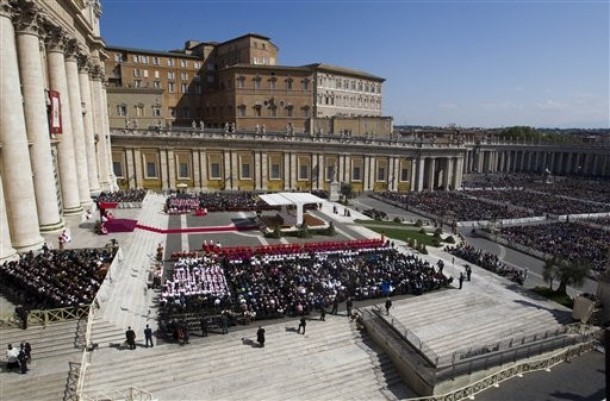
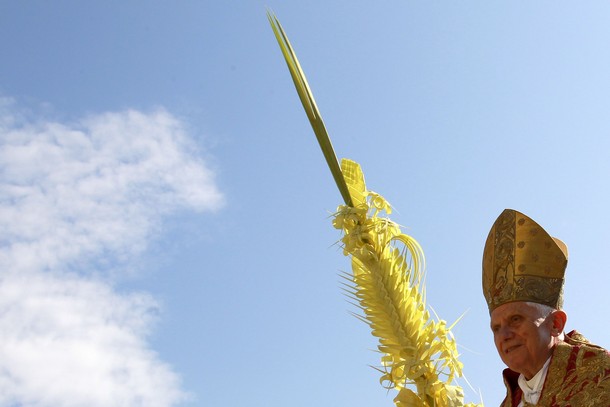

… The Holy See has given official confirmation that next October 27, in Assisi, Benedict XVI will preside over a day of «reflection, dialogue and prayer» … And he has already made it known that, with him as pope, the next encounter in Assisi will be reviewed and corrected, scrubbed clean of the slightest hint of the assimilation of the Catholic Church to other faiths. But all the same, the traditionalists are not forgiving him for this. …
Sandro Magister skrev for noen dager siden om flere tradisjonalisters skuffelse over pave Benedikt (les om det her), og hovedproblemet deres er at han forsvarer alle dokumentene fra Vatikankonsilet – men kristiserer ganske grundig deler av utviklinga etter konsilet. For flere tradisjonalister kritiserer også selve konsilet; selve dokumentene, eller (helst) helheten i det som skjedde under konsilet (dvs. hva mange biskoper ønsket (og klarte) å gjøre ved å få vedtatt mange nokså upresise dokumenter). Slik skriver Magister (men les gjerne hele artikkelen):
The pope errs – in their view – when he limits his criticism to the deterioration of the postcouncil. Vatican II, in fact – again, in their view – was not only poorly interpreted and applied: it was itself a source of errors, the first of which was the renunciation of the Church’s authority to exercise, when necessary, a magisterium of definition and condemnation; the renunciation, that is, of the anathema, in exchange for dialogue. …
La meg bare gjøre det ganske klart at jeg ikke deler denne kritikken av vår pave.
Father Z. skrev for nylig mer om den kommende presiseringen av pave Benedikts «frigjrøing» av den tradisjonelle latinske messen:
… The claim was made that after the Instruction was drafted by the Pontifical Commission “Ecclesia Dei“, the President of the same who is also Cardinal Prefect of the CDF, Card. Levada, perhaps with the aid of Card. Canizares of the CDW, made it far more restrictive.
The Instruction went to the Pope for his approval.
In the meantime, various people intervened.
The Pope has, if the claims are correct, caused the previous, favorable draft, to be adopted. It will favor, rather than restrict, the provisions of Summorum Pontificum.
Though this is all at the level of rumor, it is nonetheless plausible. …
Ifølge dette var det pave Benedikt selv som ønsket at det nye dokumentet ikke skulle begrense bruken av den tradisjonelle messen på noen måte. Om denne informasjonen / disse ryktene viser seg å være korrekte, vil vi finne ut etter hvert.
I siste utrdag fra biskop Elliots foredrag i Oklahome 11/3 (Les hele foredraget her.) tar jeg med det han skriver om messens to former:
… Cardinal Ratzinger accepted the post-conciliar liturgical reforms. At the same time, he never concealed his abiding love for the venerable pre-conciliar liturgy, the Missale Romanun of Blessed. John XXIII, 1962. This was not just nostalgia for majestic celebrations of the pre-conciliar liturgy in Bavaria, rather a view informed by the hermeneutic of continuity. As cardinal he did not hesitate to associate himself with those who, often by making many sacrifices, worked hard to maintain and promotethe pre-conciliar rite.
Reverence for God and love of the mystery of liturgy, informed his Motu Proprio Summorum Pontificum (2007) which established the pre-conciliar liturgy, the Missale Romanum of Blessed John XXIII, as the “extraordinary” form of the Roman Rite, parallel to the “ordinary” form, the Missale Romanum of Pope Paul VI. These are “two expressions of the Church’s Lex orandi” and “two usages of the one Roman Rite”. A distinction is made between the “ordinary” form, the Mass we use in the missal of 1970, and the “extraordinary” form, the pre-concilicar rite. This play on words, “ordinary” and “extraordinary” seems preferable to speaking divisively of the “Novus Ordo” and the “usus antiquior”. It presents two ways of celebrating the one Mass of the Roman Rite, two ways meant to be complementary, meant to inform and enrich one another. When both forms are celebrated reverently and prayerfully, the glory of God can be seen in our world. …
I fjerde (og nest siste) utdrag fra biskop Elliots foredrag om pave Benedikts syn på liturgien tra jeg med det han sier om at «skjønnheten i messen viser Guds herlighet»:
(The Pope) calls us by his word and example to set aside the banal. To use what is beautiful, be it old or new: the best vessels, fine vestments, good design and architecture, gracious ceremonial, excellent music. This is not mere aestheticism because is derived from the God who is beautiful, the Lord of the Eucharist. The Holy Eucharist, sacrifice and sacrament, shapes liturgy and evokes human creativity in art and music. ….
Therefore, as cardinal and later as Pope, he affirms that Catholic worship should reflect the cosmic order and harmony of the divine Logos, creation stamped with reflections of the Triune God. St Augustine’s understanding of God as beautiful is a major influence here, for he is deeply attached to the great Doctor of the West.
By contrast, as anyone can see, a feature of the hermeneutic of discontinuity or rupture is a tendency towards ugliness, or at least promoting a modernist aesthetic, often dull, cold or minimalist – ugly churches, vestments, vessels etc, and all bereft of mystery. But the God we worship and praise is beautiful, to be worshipped in the beauty of holiness, worshipped “in spirit and in truth”. That is why Catholic liturgy in all its forms, simple or solemn, Eastern or Western, captures something of the glory of God.
However the Divine Liturgy is always the Great Prayer of Christ in his Church, human prayer in time taken up into Christ’s eternal prayer. Therefore the Holy Father’s offers us not just a richer theology of liturgy but a spirituality of liturgy. His spiritual vision of worship inspires and animates what is already being called “the new liturgical movement”.
Les hele foredraget her.
I mitt tredje utdrag fra biskop Elliots foredrag om Ratzinger og liturgien tar jeg med det han sa om hvor viktig alteret er (alteret må aldri bli et spisebord!):
(The pope then) directs us away from ourselves and back to God by focusing on the Christian altar, the great sign of Christ among us. In Feast of Faith and The Spirit of the Liturgy he argued that the altar is not a setting to display a man (a Pope, bishop or priest). One might add that the altar is not a lectern or pulpit. Rather, during the action of the liturgy, the altar itself should draw us around Jesus Christ crucified and risen. This breaks down that self-centric community tendency.
Therefore he shows us a way that helps us “turn to the Lord” whenever Mass is celebrated facing the people. At all papal Masses, the crucifix now stands at the centre, no longer to one side. It is flanked by candles, of a significant size. This arrangement is being called the “Benedictine Altar”. It restores glory to our altars, especially when ornaments of fine quality are used and the altar is vested in a noble antependium.
Having made this change in the parish where I live, I learnt that once the crucifix is the centre of the altar, it becomes visually “an altar”, the great sign of Christ. No longer is it a kind of dining table adorned with candles and flowers. Placing the crucifix at the centre of the altar has also involved the recovery of the pontifical altar at his Masses in St Peter’s Basilica and elsewhere, that is, using the seven candles required by Roman tradition and the General Instruction whenever the Diocesan Bishop solemnly celebrates the Eucharist.
Les hele foredraget her.
Biskop Elliot snakket 11. mars også om pave Benedikts syn på liturgien som en levende ting som må utvikles organisk, og om hvordan fokus i liturgien alltid må være rettet mot Gud:
Cardinal Ratzinger’s critique of liturgical discontinuity rested on the conviction that authentic liturgical development is always organic. This understanding was favoured by the Fathers of the Second Vatican Council in Sacrosanctum Concilium. But changes that followed the Council were not always organic. As he bluntly put it, organic growth was replaced, “…as in a manufacturing process, with a fabrication, an on the spot banal product.”
Change in liturgy should not be concocted by committees or individuals or produced by experiments. That undermines the foundation of liturgical continuity – that liturgy is a gift, from God, through the Church. Yet he is frank about past problems, comparing the liturgy to an endangered fresco preserved by whitewash, which was stripped away, only to be “endangered by climatic conditions as well as by various restorations and reconstructions”.
While Catholic liturgy develops, it is a treasure handed on to us, entrusted to us by the Church. Therefore he applies to liturgy what he applies to the interpretation of the teachings of the Second Vatican Council, a “hermeneutic of continuity”, understanding the Council in the context of all preceding Councils and papal teachings. By sharp contrast, the “hermeneutic of discontinuity” breaks with the past and interprets liturgy as our creation, what “we do”, or as we hear in some quarters, what we do when “we gather”, adorned with such inventions as “gathering hymns” and a “gathering rite”. …
…. We note how our Holy Father reminds us that in worship we are meant to focus on God, to give God the glory, not to glorify ourselves. He criticized a self-centered overemphasis on ourselves that has damaged the quality of worship. When the liturgical community turns in on itself, it ends up worshiping itself. Self-centric worship is supposed to “build up community”, but in practice it undermines community. “Only when the sacrament retains its unconditional character and its absolute priority over all communal purposes and all spiritually edifying intentions does it build community and edify humans.”
Les hele foredraget her.
Biskop Peter J. Elliot fra Australia var nylig (11/3) i USA, (Tulsa, Oklahoma) og holdt et foredrag han hadde kalt «THE GLORY OF THE LITURGY: POPE BENEDICT’S VISION». Etter å ha innledet med å snakke om tidsaspektet i frelseshistorien og i liturgien, og om liturgiens kosmiske karakter, sier han:
His cosmological vision of the Eucharist explains the Pope’s appreciation for celebrating the Eucharist ad orientem, that is, towards the East.8 Led by the priest, the pilgrim people turn towards the Light of the risen Lord, reigning in his cosmos and coming again in his parousia. As cardinal he was well aware of the cultural difficulty of appreciating this ancient universal Christian symbolism in the secularized Western World.9 But he did not even consider that ignorant expression we still hear, celebrating Mass “with his back to the people”. That misses the whole point of the priest who is leading a worship procession towards the Lord.
As a cardinal he was not popular for putting that view. He partly challenged the most obvious and prevalent post-conciliar change, the almost universal practice of moving altars and celebrating Mass facing the people.10 As I shall explain, at the same time he gives us a way to enrich Mass facing the people by focusing on the Lord.
Moreover while he integrates the sacrificial dimension and the meal dimension of the Mass, he rejects the meal as the paradigm for the Eucharistic liturgy. The term “meal” in German and English cannot convey the depth of the liturgical action and its Passover roots.11 Nor does he accept “sacrificial meal” – which still gives the meal priority. He favors a deeper understanding of the priority of Sacrifice through a Hebrew concept of sacrifice, personalized and internalized in the self-immolation of Christ crucified and risen.
Our Pope invites us to see the glory of Christ Priest and Victim in the liturgy. He leads us into this glory, above all by his own example of a priest humbly entering the divine mysteries of the altar. By word and demeanor he reminds us that liturgy is a gift to be received in humility, not something we construct for ourselves, not a fabrication. Here he strongly rejects a decadent style of liturgy that set in soon after Vatican II. That style was contrived to be a deliberate break with the past.
Les hele foredraget her.
Det var litt diskusjon hos oss i går, om hvordan man skal gi folk asken på askeonsdag. I Norge er det vanligst å tegne (fuktig) aske på pannen, som et lite kors. I Polen, hørte jeg i går (og også i flere andre land), er man bare vant til å drysse litt (tørr) aske oppå hodet. Videoen over viser at pave Benedikt bruker den sistnevnte løsninger. Gjelder dette hele Roma og hele Italia også?
I sitt fastebudskap i år (hele budskapet kan leses her) fokuserer pave Benedikt alle mest (syns jeg) på hvordan vi i fasten skal forsøke å fornye og styrke vår dåpspakt:
Kjære brødre og søstre,
Fastetiden, som fører oss til feiringen av Den hellige påske, er for Kirken en høyst verdifull og viktig liturgisk tid. I henhold til dette er jeg glad for å gi et spesielt bidrag til at den måtte bli gjennomført med sann innlevelse. Mens det venter på det endelige møte med sin Brudgom i den evige påske, er Kirkens fellesskap flittig i bønn og gir nestekjærlige gaver, og intensiverer sin ferd med å rense ånden, slik at det fra forløsningens mysterium kan motta ytterligere nytt liv i Kristus, Herren.
1. Dette nye livet ble allerede gitt oss på vår dåpsdag, da vi «fikk del i Kristi død og oppstandelse. Da begynte for oss «hans disiplers glade og triumferende eventyr». I sine brev insisterer Paulus stadig på det spesielle fellesskap med Guds sønn som denne vaskingen frembringer. Det faktum at dåpen i de fleste tilfeller blir mottatt i spedbarnsalder, peker på hvordan den er en gave fra Gud. Ingen fortjener det evige liv gjennom sine egne anstrengelser. …. En spesiell forbindelse knytter dåpen til fastetiden som den gunstige tid til å erfare den frelsende nåde. Fedrene i Det annet vatikankonsil oppfordret alle Kirkens pastorer til å gjøre mer bruk av «de dåpstrekk som hører til fastetidens liturgi». I virkeligheten har Kirken alltid assosiert påskevigilien med feiringen av dåpen: Dette sakramentet realiserer det store mysterium der mennesket dør fra synden, blir gjort til deltager i livet til den oppstandne Kristus, og mottar den samme Guds ånd som reiste Jesus opp fra de døde.
2. For å kunne foreta vår reise mot påsken mer alvorlig, og forberede oss på å feire Herrens oppstandelse – den gladeste og mest høytidelige fest i hele det liturgiske år – hva kunne være riktigere enn å la oss selv bli ledet av Guds ord? Av denne grunn leder Kirken oss i søndagenes evangelietekster i fastetiden til et særlig intenst møte med Herren. Den kaller oss til igjen å følge skrittene i den kristne innføring: for katekumener i forberedelsen til å motta gjenfødelsens sakrament: for de døpte, i lyset av de nye og avgjørende skritt som skal bli tatt i Kristi etterfølgelse, å gi seg selv ytterligere til ham. …..
3. Gjennom å senke oss ned i Kristi død og oppstandelse gjennom dåpens sakrament, beveges vi hver dag til å befri våre hjerter fra byrden av materielle ting, fra et egosentrisk forhold til «verden» som gjør oss fattige, og forhindrer oss i å være tilgjengelige og åpne for Gud og vår neste. I Kristus åpenbarer Gud seg som kjærlighet (jfr. 1 Joh. 4,7-10). Kristi kors, «korsets ord», manifesterer Guds frelsende kraft (jfr. 1 Kor 1,18) som er gitt for å reise menn og kvinner opp på ny, og bringe dem frelse: Det er kjærlighet i dens mest ekstreme form (jfr. encyklikaen Deus caritas est, n. 12). Gjennom den tradisjonelle praksis med faste, almisser og bønn, som er et uttrykk for vår forpliktelse til omvendelse, lærer fasten oss hvordan vi skal leve Kristi kjærlighet på en stadig mer radikal måte. ….
Kjære brødre og søstre, gjennom det personlige møte med vår forløser, og gjennom faste, almisser og bønn, fører omvendelsens reise oss mot Påsken for å gjenoppdage vår dåp. La oss i denne fastetiden fornye den mottagelse av nåde som Gud skjenket oss i det øyeblikket, slik at den kan opplyse og lede alle våre handlinger. Hva sakramentet betyr og realiserer, er vi kalt til å erfare hver dag gjennom å følge Kristus på en stadig mer sjenerøs og autentisk måte. På denne vår reise, la oss betro oss til Jomfru Maria, som frembrakte Guds ord i tro og kjød, slik at vi – slik hun gjorde – kan gå inn i sønnens død og oppstandelse, og eie det evige liv.
BENEDICTUS PP. XVI
Den 41 år gamle biskopen Xavier Novell Gomá i Solsona i Spania sier:
Dette sa pave Benedikt i går under den ukentlige onsdagsaudiensen, da han snakket om den hellige Teresa av Avila. Han begynte forøvrig i går en nye serie om kirkelærerne. Slik starta han sin tale:
Dear Brothers and Sisters,
In the course of the catecheses that I dedicated to the fathers of the Church and to great figures of theologians and of women of the Middle Ages, I was able to reflect also on some men and women saints who have been proclaimed doctors of the Church for their eminent doctrine. Today I would like to initiate a brief series of meetings to complete this presentation of the doctors of the Church. And I begin with a saint who represents one of the highest examples of Christian spirituality of all times: St. Teresa of Avila (of Jesus). …
Les mer her – eller se en kort video (under).
Det er ikke første gang pave Benedikt snakker om moderne teknologi; nå sier han at den kan være nyttig for å spre evangeliet – men han peker også på begrensninger og problemer:
Pope Benedict XVI invited Christians to join online social networks in order to spread the Gospel through digital media and discover «an entirely new world of potential friendships.»
At the same time, the pope warned of the limits and the dangers of digital communication, including the risks of constructing a false online image and of replacing direct human contact with virtual relationships. …
«The new technologies allow people to meet each other beyond the confines of space and of their own culture, creating in this way an entirely new world of potential friendships,» he said.
The pope added that digital communication has built-in limits, including the one-sidedness of the interaction and «the tendency to communicate only some parts of one’s interior world.» The creation of an artificial online image instead of an authentic one «can become a form of self-indulgence,» he said.
The great potential of social networks for building relationships makes it a natural place for the church to be present, he said. But there is a «Christian way» of being online — through communication that is «honest and open, responsible and respectful of others,» he said. …
I går tok pave Benedikt opp bønneuken for kristne enhet i onsdagsaudiensen – der årets tema er fra Apost.gj. 2,42: «Trofast holdt de seg til apostlenes lære og samfunnet, til brødsbrytelsen og bønnene.» Catholic News Afency har følgende referat av pavens tale:
… Pope Benedict met with pilgrims to Rome in the Vatican’s Paul VI Hall for his weekly general audience. In observation of the annual Week of Prayer for Christian Unity (Jan. 18-25), he based his message on «the gift of full communion.»
Christians take part in the week of prayer for unity «to bear witness to the profound ties that unite them and to invoke the gift of full communion,» said the Pope.
«They devoted themselves to the Apostles’ teaching and fellowship, to the breaking of bread and the prayers» is the theme of this year’s prayer week for the unity of Christians. Pope Benedict said that this passage from the Acts of the Apostles offers a vision of four characteristics that defined the first Christian community in Jerusalem «as a place of unity and love.»
In the teaching of the apostles, in fraternal communion, in the breaking of bread and in prayer are four «pillars» that continue to be the foundation of Christian life and build Church unity, he explained.
Every effort to increase unity must involve increased faithfulness to the teaching of the first Christians, the apostles, the Pope said. «Even today,» he explained, «the community of believers recognizes the norms of its own faith in that reference to the teaching of the Apostles.»
Fraternal communion was «the most tangible expression of unity between disciples and the Lord, especially for the outside world,» he pointed out.
Although it has not been without difficulty, the history of relations between Christians of all types is one of «fraternity, of co-operation and of human and spiritual sharing,» he said.
The Pope moved to the third characteristic, the «breaking of bread,» calling it the «pinnacle» of man’s union with God. As a way of unifying oneself with Christ’s sacrifice, he said, «it also represents the completeness of the unity of Christ’s disciples, full communion.»
Christians’ prayers take on a «penitential dimension» when one considers that at this moment it is impossible to share the Body of Christ with all Christians in the Eucharist, the Pope said.
He encouraged a «more generous commitment» to eventually bring Christians together in full communion, «breaking the Eucharistic bread and drinking from the same chalice.»
The final «pillar,» he said, is that of prayer. It means being open to the fraternity offered to Christians as the children of God, but also «it means being ready for forgiveness and reconciliation,» he explained. …
En engelsk katolsk prest, Fr. Ray Blake, sammenligner opptagelsen og ordinasjonen av tidligere anglikanske biskoper med butikkenes billisalg i januar:
January Sales and the Ordinariate for some reason seem to juxtapose themselves in my mind.
Anglican former bishops moving, gliding almost, from the CofE to the Catholic Church, being ordained within just over a fortnight, priesthood following diaconate almost without a breath in between. It seems as if the Pope has flung open the doors and is offering admittance to the Church at bargain basement prices. It throws our whole rather complex sense of «RCIAing» people into confusion, it is bit like Philip and the Ethiopian eunuch, a quick discourse on a passage of Isaiah and baptism, and that was it, no more, not even the Eucharist. Presumably what Philip was looking for was faith. The same with Ordinariate.
All that is required is an affirmative response to the question, «Do you you believe in contents of the Catechism of the Catholic Church? and can you say also say that you believe and profess all that the holy Catholic Church teaches, believes and proclaims to be revealed by God? That is all, anything else is froth. …
… It is easy to be niggardly about the Ordinariate but the Pope has opened wide the door to those who had mistakenly thought they were already part of it. It is up to us to to follow the example of his generosity. It is like the January sales, Grace is freely available at bargain prices – just like Pentecost – but Grace often appears cheap but the cost is to follow Christ on the narrow way. For those who set out on the Ordinariate path the cost seems to be a little like cost paid by founding colonist on a strange shore, estrangement from friends and all that is familiar, after the initial euphoria there will be the dull daily slog, for the rest of us the cost is learning generosity. …
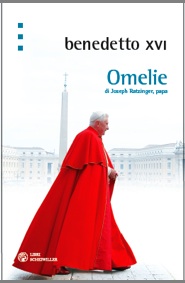 Sandro Magister skriver om utgivelsen av pave Benedikts prekener for året 2010:
Sandro Magister skriver om utgivelsen av pave Benedikts prekener for året 2010:
«LIKE POPE LEO THE GREAT, POPE BENEDICT WILL ALSO GO DOWN IN HISTORY FOR HIS HOMILIES» …
The homilies for Mass and vespers are a cornerstone of this pontificate, not yet understood by all. Joseph Ratzinger writes them to a large extent by hand, and improvises some of them with the immediacy of the spoken word. But he always thinks them through and prepares them with extreme care, because for him they have unique value, distinct from all his other written or spoken words. The homilies, in fact, are part of the liturgical action, or rather they are themselves liturgy, that «cosmic liturgy» which he has called the «ultimate goal» of his apostolic mission, «when the world in its entirety will have become liturgy of God, adoration, and so will be safe and sound.» There is a great deal of Augustine in this vision of Ratzinger’s, there is the city of God in heaven and on earth, there are time and the eternal. In the Mass, the pope sees «the image and the shadow of the heavenly realities» (Hebrews 8:5). His homilies are intended to life the veil.
And in effect, in rereading them, they disclose a vision of the world and of history full of new meanings, which are the heart of the Christian good news, because «if Jesus is present, there no longer exists any time devoid of meaning and empty.» … …